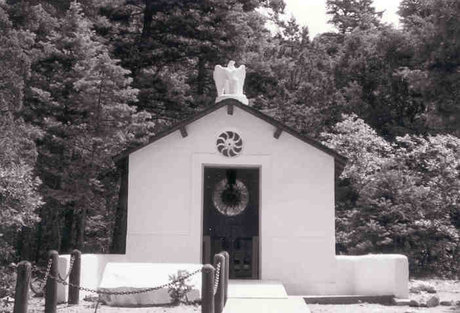Nomination Appendix 4: (Essay)
National Register Nomination for the D.H. Lawrence Ranch


EXCERPT FROM THE FINAL VERSION OF "PAN IN AMERICA" BY D.H. LAWRENCE
ORIGINALLY PUBLISHED IN THE SOUTHWEST REVIEW (JAN., 1926)
[This article begins]:
At the beginning of the Christian era, voices were heard off the coasts of Greece, out to sea, on the Mediterranean, wailing: "Pan is dead! Great Pan is dead!"
The father of fauns and nymphs, satyrs and dryads and naiads was dead, dead, with only the voices in the air to lament him. Humanity hardly noticed.
Later in the article, Lawrence continues with a complete description of the Lawrence tree which stands in front of the Lawrence cabin, using it to demonstrate his life philosophy (below). The tree is a contributing site within our district classification. This is the same tree Georgia O’Keeffe painted in 1929, entitling the painting “The Lawrence Tree”.]
And yet here, in America, the oldest of all old Pan is still alive. When Pan was greatest, he was not even Pan. He was nameless and unconceived, mentally. Just as a small baby new from the womb may say Mama! Dada! whereas in the womb it said nothing, so humanity, in the womb of Pan, said nought. But when humanity was born into a separate idea of itself, it said Pan!
In the days before man got too much separated off from the universe, he was Pan, along with all the rest.
As a tree still is. A strong‑willed, powerful thing‑in‑itself, reaching up and reaching down. With a powerful will of its own it thrusts green hands and huge limbs at the light above, and sends huge legs and gripping toes down, down between the earth and rocks, to the earth's middle.
Here, on this little ranch under the Rocky Mountains, a big pine tree rises like a guardian spirit in front of the cabin where we live. Long, long, ago the Indians blazed it. And the lightning, or the storm, has cut off its crest. Yet its column is always there, alive and changeless, alive and changing. The tree has its own aura of life. And in winter the snow slips off it, and in June it sprinkles down its little catkin‑like pollen‑tips, and it hisses in the wind, and it makes a silence within a silence. It is a great tree, under which the house is built. And the tree is still within the allness of Pan. At night, when the lamplight shines out of the window, the great trunk dimly shows, in the near darkness, like an Egyptian column, supporting some powerful mystery in the over‑branching darkness. By day, it is just a tree.
It is just a tree. The chipmunks skelter a little way up it, the little black‑and‑white birds, tree‑creepers, walk quick as mice on its rough perpendicular, tapping: the blue jays throng on its branches, high up, at dawn, and in the afternoon you hear the faintest rustle of many little wild doves alighting in its upper remoteness. It is a tree, which is still Pan.
And we live beneath it, without noticing. Yet sometimes, when one suddenly looks far up and sees those wild doves there, or when one glances quickly at the inhuman‑human hammering of a woodpecker, one realizes that the tree is asserting itself as much as I am. It gives out life, as I give out life. Our two lives meet and cross one another, unknowingly: the tree's life penetrates my life, and my life, the tree’s. We cannot live near one another, as we do, without affecting one another.
The tree gathers up earth‑power from the dark bowels of the earth, and a roaming sky‑glitter from above. And all unto itself, which is a tree, woody, enormous, slow but unyielding with life, bristling with acquisitive energy, obscurely radiating some of its great strength.
It vibrates its presence into my soul, and I am with Pan. I think no man could live near a pine‑tree and remain quite suave and supple and compliant. Something fierce and bristling is communicated. The piny sweetness is rousing and defiant, like turpentine, the noise of the needles is keen with aeons of sharpness. In the volleys of wind from the western desert, the tree hisses and resists. It does not lean eastward at all. It resists with a vast force of resistance, from within itself, and its column is a ribbed, magnificent assertion.
I have become conscious of the tree, and of its interpenetration into my life. Long ago, the Indians must have been even more acutely conscious of it, when they blazed it to leave their mark on it.
D.H. Lawrence and New Mexico, ed. Keith Sagar
(Paris and London: Aylscamps Press, 1995), pp. 39, 40‑41.



